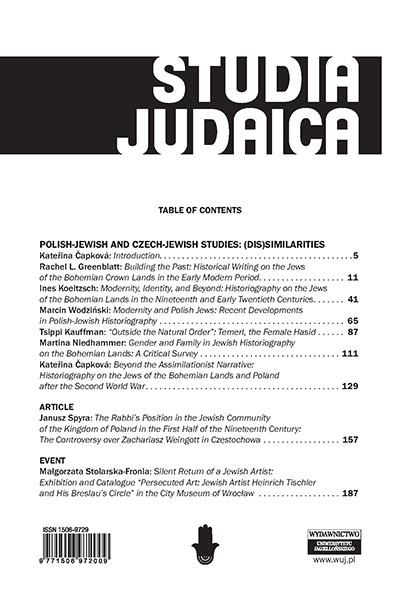Miejsce rabina w gminie żydowskiej w Królestwie Polskim w I połowie XIX wieku. Spór o Zachariasza Weingotta w Częstochowie
The Rabbi’s Position in the Jewish Community of the Kingdom of Poland in the First Half of the Nineteenth Century: The Controversy over Zachariasz Weingott in Częstochowa
Author(s): Janusz SpyraSubject(s): Jewish studies, Jewish Thought and Philosophy, History of Judaism
Published by: Wydawnictwo Uniwersytetu Jagiellońskiego
Keywords: rabbis; the Kingdom of Poland; Częstochowa; Zachariasz (Yisakhar) Weingott; modernization; Orthodoxy; Hasidism
Summary/Abstract: In the nineteenth century, Częstochowa was home to one of the largest Jewish communities in the Kingdom of Poland, but for most of this time it had no communal rabbi approved by both the community and the state authorities. The first such rabbi, Zachariasz (Yisakhar) Weingott, was elected in 1822, but a mere two years later he was forced to resign. The attempts to elect a new rabbi led to major social conflicts and continued to fail, while the rabbinical duties were executed by unofficial rabbis (Jakub Brass and Mojżesz Majzel). It was only in 1839 that Weingott was reelected to the post of the rabbi and held that position until his death in 1852. As it seems, the conflict was animated by a competition between adherents of modernization and the traditional segments of the Jewish community in Częstochowa, including the Hasidim. As such, it was an expression of a typical communal conflict that plagued east European Jewish communities of the nineteenth century. What seems of special interest, however, is that a detailed analysis of the Częstochowa case makes it possible to trace other—familial and business—connections, behind the well-known ideological divisions, quite often transcending traditional divisions into modernist and traditionalist camps.
Journal: Studia Judaica
- Issue Year: 19/2016
- Issue No: 37
- Page Range: 157-186
- Page Count: 30
- Language: Polish

